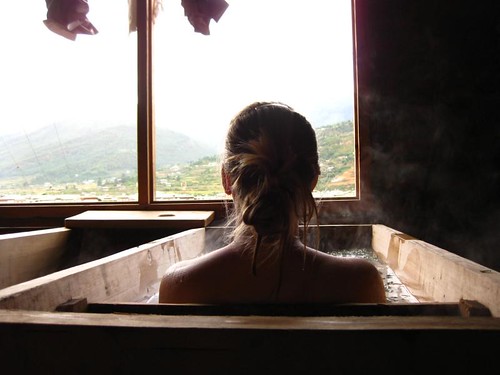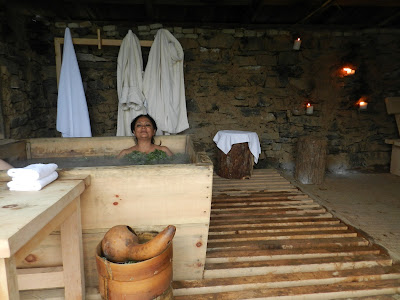The reclusive Kingdom of Bhutan is well-known for it's pursuit of happiness, would this include taking time out for soaking in hot springs?
An unknown location of a hot spring, visited by a Japanese blogger who after translation refers this as Do-unman hot spring. But it does seem that the locals have a liking of their soaks ...
Kencho Wangdi in a thoroughly informative article in the Kuensel stated the following: 'Japanese love it [soaking in hot springs], if not for its medicinal value, for its warmth and therapeutic comfort. Visitors believe the thermal springs are great for relieving stress and tension too.
Traditional medicine doctors (Dungtshos) in Thimphu [Bhutan's capital], though, say that it is not good for people with high blood pressure, eye and dizziness disease, and with heart ailments.
Gasa tshachhu’s [tsachu or tshacchu are Bhutanese for hot spring] historical records are sketchy at best as it is for numerous other tshachhus in the country. Dungtsho Yeshey Dorji of the institute of traditional medicine services says that the country’s ancient traditional medicine doctors discovered the medicinal values of the tshachhus and spread the discovery. Because of their curative powers tshachhus were held sacred by the Bhutanese, many believing them to have been touched by divine hands. It is said that Bhutanese warriors wounded in battles sought tshachhus to soak in and applied the warm mud as salve for wounds. Sometimes they traveled for weeks to bathe their wounds in the water. Traditional medicine doctors have long since been prescribing the healing waters for their patients.
Observers also speculate if with modernisation tshachhus would retain their magic for long. In the west hot springs lost out to modern medications which held out the promise for rapid cures of many chronic diseases, which seemed more attractive than several weeks of bathing and other water-related treatments. Physicians were also not all convinced of their medicinal value mainly because no scientific proof existed.
But for elderly Bhutanese like Ap Lhap Tshering, 81, from Lhuentse, a regular visitor to Gasa tshachhu, the magic will never wane. "It's nature's way of healing people."
The looks like a comprehensive answer. Bhutanese must love soaking.
In the article entitled 'The Healing Springs of Bhutan' ugina adds:
The significance of hot springs and their opportunity to attract tourists has made the government to present a December 2010 overview on their tourism web site. In all they mention 5 hot springs, this blog posting will do better ...
Read more about hot stone baths in this posting.
So where are the soak sites?
Dur tsachu (Bhumthang) is the highlight of 10-day trek traversing the Bhutanese portions of the Himalaya without it being too strenuous. The trek is actually named after the hot spring.
Despite this though there is little info on the hot springs themselves ..., that is with the exception of Wikitravel:
On yanatravel.com a first hand account to the old site as reported by Phintsho Dorji:
In the article entitled 'The Healing Springs of Bhutan' ugina adds:
'During the winter months, many people walk to these hot spring spots or "Tsachus" as they are called. People believe that soaking in this water will cure illnesses, such as stomach ailments, headache, skin problems and the list goes on and on'.The only scientific research I could find on Bhutan's hot springs (P. Wanchuk & Dorji, Y., 2007) includes:
'Tshachu literally means “hot water” and could include the man-made boiled water that is created in artificial conditions. However, as defined in the gSo-ba Rig-pa tradition, tshachu in this context means only that water originating from a “natural source and emanating from natural phenomena which have associated hot properties”. Given its origin, the water contains a combination of coal (rdo-sol), sulphur (mu-zi) and imestone (rdo-sho). Because of the presence of these minerals most of the tshachu have medicinal value. Spiritually, it is believed that tshachu owe their origin to the good wishes and blessings of Buddhas and Boddhisattavas. Hence, almost all tshachu are also held to be gNyes (sacred sites)'.Which is a lot more than modern day wellness centers can give... It includes information that Bhutan plays host to 10 hot springs, though I'll be able to get references to 9 ....
The significance of hot springs and their opportunity to attract tourists has made the government to present a December 2010 overview on their tourism web site. In all they mention 5 hot springs, this blog posting will do better ...
Lhaden in the hot springs, Gasa by John Wehrheim.
But when talking about the Bhutanese love of hot water one must also mention the existence of the typical Bhutanese custom of hot stone baths. Spring water is diverted into wooden tubs to which are added stones which have been heated over a fire often for hours on end. The result: bliss!
So where are the soak sites?
Dur tsachu (Bhumthang) is the highlight of 10-day trek traversing the Bhutanese portions of the Himalaya without it being too strenuous. The trek is actually named after the hot spring.
Despite this though there is little info on the hot springs themselves ..., that is with the exception of Wikitravel:
'A one day trek from road head. The trek is arduous, but stunningly beautiful. Blue sheep, musk deer and Himalayan bear are common in the Duer Hot Spring area'.A short story on the keeper of Dur hotspring (my ambition) by crankygerman:
'... he will show you with a wry smile how to disrobe and make proper use of them'.Another hot spring (known as Gasa Tsachu) is likewise known as it is en-route on the more worn out trekking trails of Bhutan. It is (or was) actually the main destination of a 11-day trek.
On yanatravel.com a first hand account to the old site as reported by Phintsho Dorji:
'The hot springs have five ponds. Each is fed from the different springs and each treats a different ailment. Though there are bathrooms and shower rooms and a notice instructing the visitors, ‘Do not enter the pond before taking shower from this bath house’, people enter the ponds without taking bath and that too with their dirty clothes on'.
In 2009 however, it saw a washout occur when a nearby stream managed to undercut the bathing facilities as reported by Kuensel (12 July 2009):
'The healing waters of the country’s most famous hot spring now flow under the Mochu river, which has taken a new course after the May 26 flood that completely washed away the five soaking ponds and the VIP bathhouse built around the spring'.Reports since though have reported that renovations are underway.
'This area used to be green, lush, and developed with many tubs before the flood in 2009. There is now one pool in the hut and an other outside, along with the bathing area to the lower right of the pool'.Photo by Craig Learned.
An update on Soaking in Southeast Asia refers to a bidding war by Japanese and Italians ..., while in October 2012 the same site mentions that the hot spring is open for business again.
Though there is the reality of the conditions of the Gasa tsachu and development in general as reported by tripadvisor:
Some things never change or do they?
 Erik Skydive's picture on Gasa TsaChu as it was.
BBS reports (April 2013) that full development will require another two years:
Erik Skydive's picture on Gasa TsaChu as it was.
BBS reports (April 2013) that full development will require another two years:
Overall Mr. Wangdi (see above) has a very informative article not only on Gasa but on hot springs in Bhutan in general (see also above fragment in the introduction). He also mentions:
Looking further back in time, this site comes with a plausible reason why the spring is sacred:
Though there is the reality of the conditions of the Gasa tsachu and development in general as reported by tripadvisor:
'Gasa Tshachu trek is no more an attraction after the hot spring was washed away by the flood this year. Now there is dirt track just four hours walk from Gasa and two hours from the hot spring site'.The former refers to the new road which now makes the trek just 2-3 hours away from the roadhead. Bhutan Observer (originally from 29 May 2009, the link now not functioning):
'Passang, 55, a horseman from Zomina, said before the arrival of the road, he used to get Nu 400 for a horse to carry a person and his luggage from the road end at Tashithang to the tshachhu [Gasa hot spring]. But now, he gets only Nu 300 for a horse. He said the coming of the road would directly affect the livelihood of about 100 horsemen'.The road seems to be on. The Bhutanese reports (24 March 2012) on the road initiative. The locals seem to be intent on the road passing near or through the hot springs area, whereas officials are arguing that they will never get the environmental clearance. In that case the road would by-pass the hot springs by 3-4 km.
Some things never change or do they?
'In the past, visitors relieved themselves in the open and farmers brought domestic animals - pigs, horses and cows to the tshachhu for broken joints and other ailments. Animals are now banned from the tshachhu'.That positive note from Kencho Wangdi in the Kuensel (14 January 2009).
 Erik Skydive's picture on Gasa TsaChu as it was.
Erik Skydive's picture on Gasa TsaChu as it was.'The Gasa Dzongdag [local governor] , Sonam Jigme, says works on the guest houses are not complete yet and the dzongkhag will need at least two more years for the entire hot spring site to be completed. there are plans for a medical unit, a lhakhang, and even a parking lot at the site.Prayer
The Dzongdag told BBS that confusion over the completion of the site had begun aftersome media reports claimed the hot spring had been completed, encouraging premature visits to the hot spring'.
Overall Mr. Wangdi (see above) has a very informative article not only on Gasa but on hot springs in Bhutan in general (see also above fragment in the introduction). He also mentions:
'... Nye [hot spring] in Kurtoe, Chuphu in Punakha and Dunbang in Zhemgang. They are all difficult to reach and entail more than a day’s walk through the rugged terrain'.
The already mentioned Wanchuk & Dorji (2007) have an extensive overview of what they refer to as gNye hot spring noting that it is the most sacred of Bhutan's hot springs. Actually existing out of three distinctive pools, these springs see little soaking folk due to it's remoteness.
What a waste
Chuphu is much better known as Chubu. Or Chhubu. As stated above, it is located in Punakha, Chubu is often visited.
From recent photo's (by yasu kita) it is evidently a very rustic affair; a small cemented pool with a low corrugated iron roof over it. Already a decenium ago, local government mentioned that
'Many of these traditional practices described for the visitors to Kurtoe gNyes tshachu may apply to all the tshachu and their users. First and foremost, on arrival, people pay homage to the Guardian Deity of the tshachu by offering a specific prayer. The Guardian Deity of the gNyes tshachu is called gNod-sbyin-rgod-ma-kha and his homage prayer is as follows:It continues:
gNod-sbyin-chen-po-rgod-ma-kha
Ngyur-smrig-gos-gyon-rkang-gling-'budKha-char-bu-yubs-thog-ser-gtong
Yul-bdag-chen-po-khyod-la-bstod'.
'While visiting the Kurtoe gNyes tshachu, people believe that the Guardian Deity gNod-sbyin-rgod-ma-kha disapproves of the following:Not much is known about Dunbang hot spring, though I suspect it refers to Dunmang, see below.
1. The presence of clothes of the dead or of those
attending the delivery of babies.
2. Shouting or whistling loudly.
3. Throwing meat or blood in the source of tshachu and
its surrounding areas.
4. Burning meat or animal skin.
5. Defecating or urinating in the tshachu pools.
6. Having sexual intercourse inside the tshachu pools.
7. Bathing in pairs especially couples, and
8. Women and girls bathing when menstruating'.
What a waste
Chuphu is much better known as Chubu. Or Chhubu. As stated above, it is located in Punakha, Chubu is often visited.
From recent photo's (by yasu kita) it is evidently a very rustic affair; a small cemented pool with a low corrugated iron roof over it. Already a decenium ago, local government mentioned that
'The Tshachhu, however, lacks proper pond and accommodation facilities'.Does not look like much has changed since.
Looking further back in time, this site comes with a plausible reason why the spring is sacred:
'Many great master visited this Landlocked country in different centuries. As well during 8th century, the great Ngingmapa Master Guru Padmasambhava (lotus born) visited Bhutan, subdued the evils and blessed whole corner of the valley where he also introduced Hot spring for the well being of the sentient [= responsive, perceptive] beings. So, with the strong believes, hundreds of people hiked to the particular places where they have hot spring to take bath, especially the victims of different sorts of diseases. And by taking bath in the hot spring, it can heals different kinds of diseases like Tuberculosis, sinus, body-ache etc'.
Sangey Tashey in a very recent blog mentions that due to a new road it's only a 2-3 hour walk.
The above photo comes from this website and contains many a detail about the place as well as daily life during the soaking season. It notes:
'The place is muddy and humid. But it’s seething with heat. It is far-flung and inhospitable. But the place is throbbing with life. Chhubu Tshachhu (hot springs) in Punakha is nature at its most bountiful. Located at 2,930 metres above sea level, Chhubu hot springs are more than two hours’ walk from the road head in Walathang from where visitors hire horses to carry their rations mostly comprising local rice, meat, butter, cheese and eggs. The mountain trail gently snakes through a chir pine forest into the cool, temperate mixed forest.
The hot springs see a chain of people from across Bhutan for more than six months in a year. In the last month of the Bhutanese calendar, the hot springs gushing out of the steep, swampy hillside are inundated with more than 1,000 visitors, says Namgay Wangchuk, 57, the caretaker of the tshachhu. Namgay Wangchuk is popularly known by the title nedag (estate owner) but he says the title is inappropriate because he believes that the ‘real nedag’ or local deities own the tshachhu and not the caretaker.
Namgay says that, during the peak season, more than 100 colourful tents sprout up near the tshachhu transforming the hillside into a vibrant village of strangers. The only guest house cannot accommodate more than 60 people.
...
Chhubu Tshachhu has two ponds separated by a flight of concrete steps. Measuring 43.50 degree Celsius, the first pond is found to cure skin and stomach diseases, tuberculosis and some minor ailments. The second pond, which is 145 average man’s steps below by the bank of the tumbling Tshachhu Phu stream, measures 45.60 degree Celsius.
...
Regular tshachhu visitors say the place surrounding the tshachhu has improved in sanitation but it has become dirtier with waste. Dorji Wangchuk, 56, from Chapcha had been to the tshachhu when he was 15. “At that time, one could hardly find a clean space to walk around,” he recollects. “Every metre of the ground surrounding the tshachhu was filled with human excreta.” After three makeshift latrines were built in 2009, sanitation has improved, but with the number of people visiting the tshachhu increasing by the year, waste management is a big challenge, says caretaker Namgay Wangchuk.
Plastic wrappers and bottles fly around. For lack of a waste disposal site, waste is regularly burnt sending fumes of intoxicating smoke into the clean mountain air. Namgay Wangchuk says burning of waste angers the deities of the place, khachep Draley Gyep and Gomo, who retaliate by causing rains and windstorms.
The tshachhu doesn’t have clean drinking water. Three outdoor taps became defunct barely a few months after they had been built by a contractor in 2009. The leaking tanks and broken pipes were never repaired.
A decent place to camp is on the top of all tshachhu visitors’ wish list.
Apart from a caretaker, who is paid Nu 100 a month by the government, there is neither an organised waste management strategy nor sanitation drive initiated at the tshachhu. A senior monk says, “The bounty of nature must be enjoyed sustainably.”
Hordes
'Koma Tsachu (Punakha) is a vigorous two hour walk from the small community of Mitesgang. There are three bathing pools covered by simple rooves, and a four roomed building with solar lighting where sleeping bags and mats can be laid (there is no charge for staying in the building). Outside, there is ample room to pitch tents and rock overhangs to camp under (source)'.
Then there is an excellent report on a visit to Koma tsachu by Phuntsok Rabten published in the Bhutan Observer (26 April 2008).
Back in 2006 the Kuensel reported on the bridge to Dunmang tsachu (Zhemgang):
'Nestled alongside the creek in this picturesque jungle were the three pools of the hot springs. Amongst the scattering of tents and makeshift camps were two public toilets, three outdoor running taps and a most decent guest house of five rooms and two attached bathrooms, facilitated with solar electricity and water supply. Here, the music of modern amenities played in rhythm with the wild beat of the jungle drums. Koma Tsachu sees revelers and visitors round the year. Spring-time sees the most influx while the student hordes invade the tsachu during holidays. There were about 30 people when we arrived'.
Complacent
Back in 2006 the Kuensel reported on the bridge to Dunmang tsachu (Zhemgang):
'“A new suspension bridge will be constructed next year,” he said. Meanwhile the travellers through the tsachu zam are advised to be careful while passing through this bridge. People as far as from Thimphu and Haa in the west and from Trashigang and Trash Yangtse in the east visit the Dunmang tsachu from November till march. The tsachu’s three ponds with water temperatures measuring between 42 degrees to 52 degrees, is believed to cure diseases like tuberculosis, and sinusitis besides healing aches and wounds. A village elder from Kheng Gongphu said that the temperature of the water had been decreasing over the years. “We used to boil eggs in the tsachu not long ago,” said Ap Sangay, 90. “In the absence of hospitals in the past, the tsachu was very indispensable for us.” Thousands of people visit the tsachu every year'.
More recent info (April 2013) from this BBS report on Dunmang (sometimes referred to as Dungmang or even Duenmang), though notably mentions the lack of facilities.
Sonam describes Dunmang as marvelous. He aslo had the following discussion:
Gaining in popularity Gelephu tshachu was once less well-known. Kuensel reported in 2003 that renovations were on the horizon.
The BBS even mentions conjunctivitis outbreak at this hot spring:
However, possibly sine the renovation the hot springs of Gulephu have seen an upswing in both visitors as well as reports.
With a characteristic stone lined pool, bathers are now packed as sardines. Reports are made that this is slightly uncomfortable ...
Yet, the Kuensel (February 8, 2013) reports that the staggered timings aren't working well. Massive visiting numbers has lead to some soakers not being able to soak, whereas others ended up injured from their soaking experience! See below, photo accompanying article:
Elsewhere
Duethang in Ura, Bumthang is expected to be another better developed hot spring site.
This link goers to a photo with the caption mentioning a hot spring at Woche village.
In all, the above notes 9 distinctive Bhutanese hot springs.
Notes:
P. Wanchuk & Dorji, Y. (2007) Historical Roots, Spiritual Significance and the Health Benefits of mKhempa-lJong gNyes Tshachu (hot spring) in Lhuntshe Journal of Bhutan Studies Vol. 16, Summer 2007, pp 112-128. Thimphu, Bhutan
Sonam describes Dunmang as marvelous. He aslo had the following discussion:
'As I went for a dip late into the night, as if in trance, I was drawn into a conversation by the meandering Mangdechhu [the nearby river!]. Of the many lessons it taught me, she cautioned me that I was already into the 25th year since I was born and that I do not have any concrete achievements to my credit. She also told me that my life was fleeting, just as her flow downstream.Seeing is believing
Upon asking about how I could overcome this crisis, she just told me very bluntly that I would rust if I chose to rest and thereby, she put an end to our conversation quite abruptly.
I am assuming, she meant that I need to conquer complacency and work rather very hard!!!'
Gaining in popularity Gelephu tshachu was once less well-known. Kuensel reported in 2003 that renovations were on the horizon.
'It will be the first major renovation since the hot springs were opened to public in 1962'.Possibly the renovations were in answer to an earlier that year published report in the Bhutan Today. In the article are mentioned inadequate bathing facilities, a decrepit guesthouse and non-existent toilets.
The BBS even mentions conjunctivitis outbreak at this hot spring:
'... the outbreak occurred after an old couple infected by conjunctivitis soaked in the Tshachu'.
Hot-tubbing Gulephu style ... (source)
However, possibly sine the renovation the hot springs of Gulephu have seen an upswing in both visitors as well as reports.
With a characteristic stone lined pool, bathers are now packed as sardines. Reports are made that this is slightly uncomfortable ...
'But in recent times, owing to the lack of separate chambers for men and women, many, who have come to soak in the hot spring, privacy, or the “lack of it”, has become an issue.'The article continues:
'To ensure this did not lead to depriving genuine users from availing the facility, they would introduce different timings for men and women, who visited the hot spring. Pema Wangdi [Gelephu dungpa = local official] said this would also ease congestion at the site while, at the same time, help to keep the tsachu clean. He said it would prevent dirtying the area, thus avoiding the spread of “skin diseases”, which many visitors complained of, once they visited the bath. The hot spring has five tubs, including the pre-bathing tub. Each can accommodate about 20 to 30 persons at a time'.
Gulephu Hot Spring (Tshachu), Bhutan (source)
Yet, the Kuensel (February 8, 2013) reports that the staggered timings aren't working well. Massive visiting numbers has lead to some soakers not being able to soak, whereas others ended up injured from their soaking experience! See below, photo accompanying article:
Elsewhere
Duethang in Ura, Bumthang is expected to be another better developed hot spring site.
This link goers to a photo with the caption mentioning a hot spring at Woche village.
In all, the above notes 9 distinctive Bhutanese hot springs.
Notes:
P. Wanchuk & Dorji, Y. (2007) Historical Roots, Spiritual Significance and the Health Benefits of mKhempa-lJong gNyes Tshachu (hot spring) in Lhuntshe Journal of Bhutan Studies Vol. 16, Summer 2007, pp 112-128. Thimphu, Bhutan





















